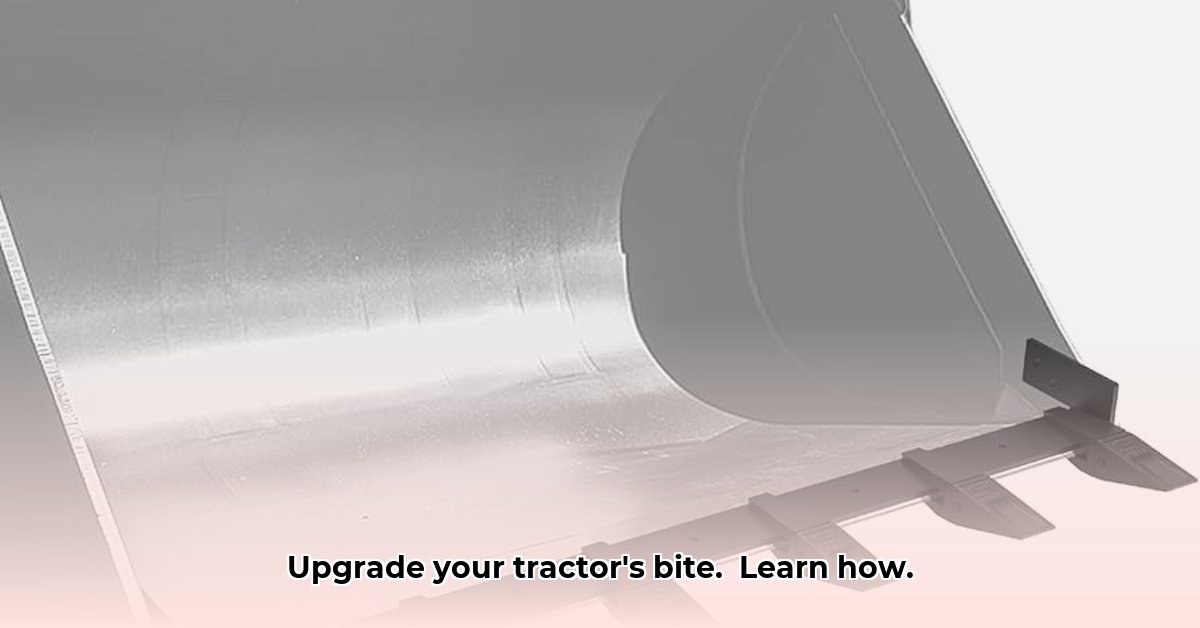
This guide provides a practical, step-by-step approach to selecting, installing, and maintaining bolt-on tractor bucket teeth for sustainable agriculture. By choosing the right teeth and ensuring their proper use, you can minimize soil compaction, improve efficiency, and potentially reduce fuel consumption. For more information on similar attachments, check out these tractor bucket attachments.
Understanding Bolt-On Tractor Bucket Teeth and Their Role in Sustainable Agriculture
Bolt-on tractor bucket teeth are crucial for efficient and sustainable farming practices. Did you know that improper tillage can significantly impact soil health? By using the right teeth, you can reduce soil compaction, leading to healthier soil structure and improved water infiltration. This, in turn, translates into better crop yields and a reduction in the need for chemical fertilizers—key elements of sustainable farming.
Choosing the Right Bolt-On Tractor Bucket Teeth
Selecting the appropriate teeth involves considering several factors: material, shape, and size. Each choice impacts your soil and your work efficiency.
Material Selection
- High-Carbon Steel: (A durable and affordable option, suitable for most soil types.) A good all-around choice for general-purpose work, but might wear down faster in especially rocky or abrasive soils.
- Boron Steel: (Offers superior toughness and a longer lifespan.) Ideal for rocky soils and heavy-duty applications, though it comes with a higher upfront cost.
- Carbide-Tipped Teeth: (The most durable option, providing exceptional resistance to wear and tear.) Best for extremely abrasive soils and situations demanding prolonged usage, although they represent a significant investment.
Tooth Shape Considerations
- Curved Teeth: (Designed for efficient penetration and minimal soil compaction.) These are excellent for digging and grading, helping preserve soil structure and water retention.
- Straight Teeth: (Optimized for material handling and less demanding tasks.) Ideal for moving materials such as gravel or manure, but not as effective for deep digging.
Size and Fit Matters
Ensure the teeth are appropriately sized for your bucket and tractor. Oversized teeth can strain your equipment, while undersized teeth will be ineffective. Always check the manufacturer's specifications to ensure compatibility.
Selecting the Perfect Teeth: A Decision-Making Guide
The following table simplifies the selection process:
| Soil Type | Primary Task | Recommended Tooth Type | Considerations |
|---|---|---|---|
| Clay/Heavy Loam | Digging/Grading | Curved, hardened steel | May require more frequent sharpening due to soil stickiness. |
| Sandy/Light Loam | Material handling | Straight, hardened steel | Generally longer-lasting due to reduced wear and tear. |
| Rocky | Excavation | Carbide tipped | High initial cost, but offers superior longevity. |
| Gravel/Debris | Material moving | Heavy-duty, straight teeth | Prioritize durability and regular inspections. |
Installing Your Bolt-On Tractor Bucket Teeth: A Step-by-Step Guide
Safety First! Always wear safety glasses and gloves.
- Preparation: Clean the bucket thoroughly, ensuring the mounting area is free from debris and old teeth. (A wire brush can be helpful.)
- Alignment: Carefully position the new teeth in the bucket's slots, ensuring a snug fit.
- Fastening: Use the appropriate wrench to tighten the bolts securely, avoiding over-tightening (which could strip the threads). A torque wrench ensures optimal tightening.
- Final Inspection: Walk around the bucket, visually checking that all teeth are firmly installed and aligned correctly.
Maintaining and Replacing Your Bolt-On Tractor Bucket Teeth
Regular maintenance significantly extends the lifespan of your teeth and ensures optimal performance.
- Regular Inspections: Check for wear, cracks, or loose teeth after each use. Early detection prevents bigger problems.
- Sharpening: Dull teeth reduce efficiency. Sharpen as needed using appropriate tools and techniques.
- Lubrication: Applying grease to the bolts (especially in humid conditions) prevents rust and maintains their tightness.
- Replacement: Replace worn or damaged teeth promptly to prevent further damage and safety hazards.
Troubleshooting Common Issues
- Loose Teeth: Re-tighten the bolts. If the problem persists, the bolts may be worn and require replacement.
- Broken Teeth: Replace immediately. A broken tooth can damage the bucket and pose a safety risk.
- Uneven Wear: This may indicate hidden rocks or an inappropriate selection of teeth for the soil type.
Conclusion: Sustainable Farming with Bolt-On Tractor Bucket Teeth
Investing in and properly maintaining bolt-on tractor bucket teeth is a significant step toward sustainable agriculture. By reducing soil compaction and enhancing efficiency, these relatively simple tools contribute to a healthier environment and more productive farm operations. By following this guide, you can optimize your farm's efficiency and environmental impact, leading to a more resilient and productive agricultural system.